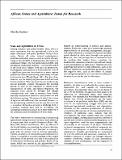African States and Agriculture: Issues for Research
Abstract
SUMMARY This article assesses the relative merits of two styles in food marketing from the perspective of small?scale producer?sellers in rural Zambia. Of the alternatives — state?controlled maize cropping; free?market bean sales — the latter has been viewed as ‘obviously’ preferable. The author challenges this view, arguing that the seemingly inferior alternative (hybrid maize) cannot be dropped from the local food system where it has become a substitute for the very labour?intensive ‘traditional’ millet. This production function explains why maize is locally perceived as a valuable crop in spite of the poor infrastructure for providing inputs and for collection. SOMMAIRE Cet article évalue les mérites relatifs aux deux styles de mise en marché d'aliments dans la perspective des producteurs?vendeurs à petite échelle en Zambie rurale. Des deux alternatives — culture de mais contrôlée par l'état: vente libre d'haricots — on a retenu la dernière étant ‘évidemment’ préférable L'auteur conteste ce choix argumentant que l'alternative semblant inférieur (le maïs hybride) ne peut être abandonnée du système local d'alimentation, puisque cela constitue un substitut au travail intensif du millet ‘traditionnel’. Cette fonction de production explique pourquoi la culture du mais est perçue localement comme étant valable en dépit de la pauvreté de l'infrastructure fournissant les apports et facilitant la vente. RESUMEN Este artículo destaca los méritos relativos de dos estilos de comercialización alimenticia desde la perspectiva de los productores?vendedores en la Zambia rural. El autor desafía la creencia de que la venta de frejoles en el libre mercado es ‘obviamente’ preferible al cultivo del maíz controlado por el estado. Argumenta, por el contrario, que el maíz híbrido — alternativa aparentemente inferior — no puede eliminarse del sistema alimentario local, donde se ha convertido en un substituto del ‘tradicional’ mijo, muy intensivo en mano de obra Esta función de producción explica por qué el maíz es percibido localmente como un valioso cultivo, pese a la pobre infraestructura existente para proveer insumos y para la recolección.

